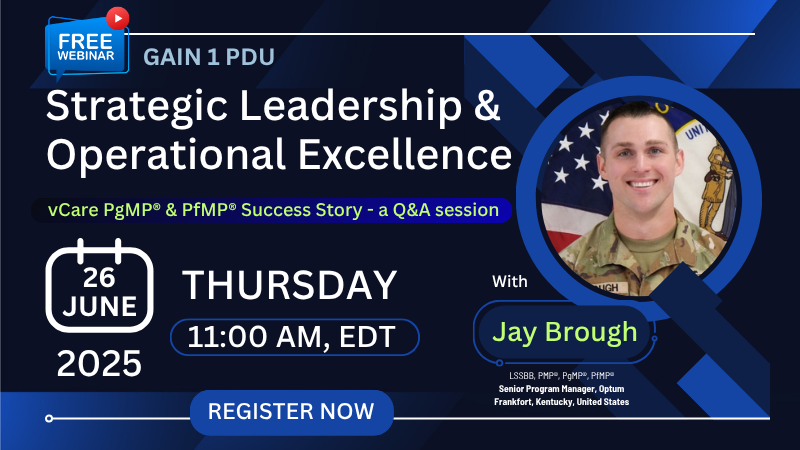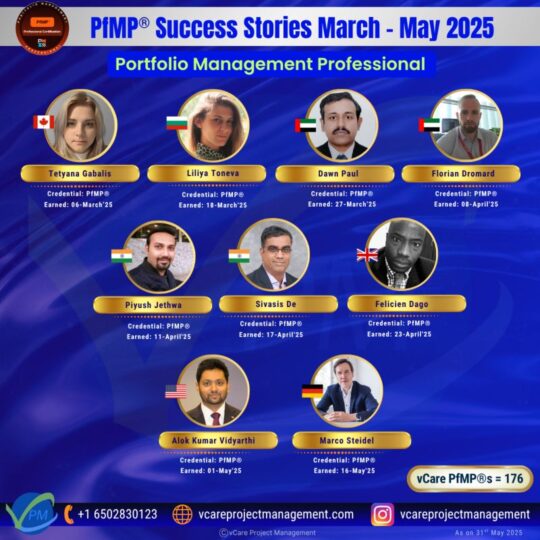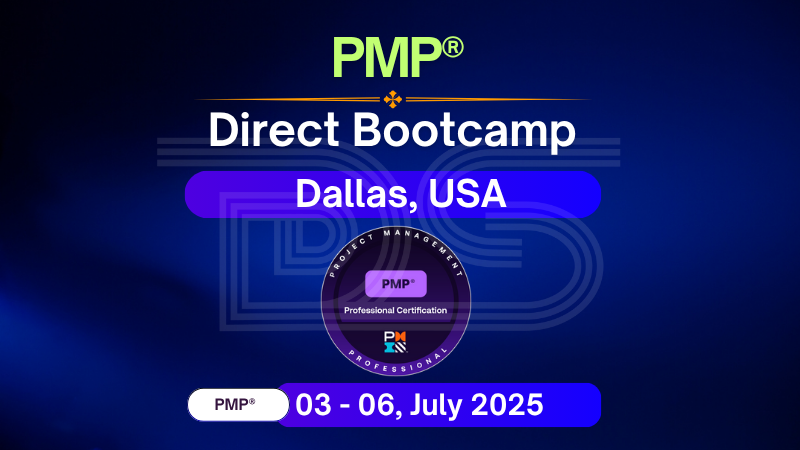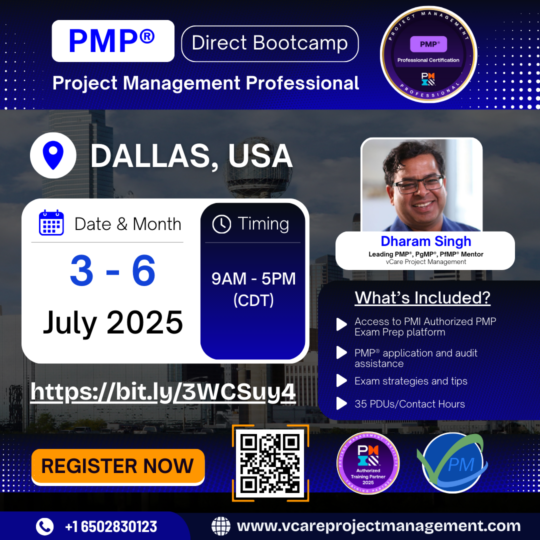
by DharamCW | Jun 17, 2025 | Professional Development Webinars
Are you a project, program, or portfolio professional ready to expand your strategic impact?
I’m excited to invite you to a special webinar where I’ll be co-hosting with Kim Marcelliano, Senior Product Manager at Project Management Institute, to spotlight PMI’s newest credential—PMO Certified Professional (PMI-PMOCP)™.
This session is designed to help you understand how this credential can empower your leadership within a modern PMO setup.
🔗 Reserve Your Spot Now: https://bit.ly/3Sp9h5l
Date: Wednesday, 02nd July 2025
Time: 10:00 AM – 11:00 AM (PDT) / 11:00 AM – 12:00 PM (MDT) / 12:00 PM – 01:00 PM (CDT) / 01:00 PM – 02:00 PM (EDT) / 02:00 PM – 03:00 PM (BRT) / 07:00 PM – 08:00 PM (CEST) / 08:00 PM – 09:00 PM (AST) / 09:00 PM – 10:00 PM (GST) / 10:30 PM – 11:30 PM (IST)
💡 What You’ll Learn:
✅ Who should pursue the PMI-PMOCP™ and why it matters now
✅ A practical breakdown of the Exam Content Outline (ECO)
✅ Eligibility, application steps, and preparation roadmap
✅ How this credential can accelerate your career as a PMO leader
✅ Plus: Exclusive discount code for PMOCP, PMP, PgMP & PfMP training
🎓 Earn 1 PDU just by attending
I look forward to sharing this virtual stage with Kim and helping you understand how to position yourself at the forefront of PMO transformation.
Upcoming PMI-PMOCP Exam Prep Training:
Online: https://bit.ly/4dKY35f
Direct Classroom: https://bit.ly/4jnDUmY
Free Consultation:
Book a free 15-minute session with me, http://talktodharam.com
Subscribe for More:
PgMP & PfMP Success Stories https://bit.ly/2YF0wJl
Dharam Singh Podcasts and Interviews: https://bit.ly/2NDY8wd
Contact Us:
Call us: +1 9722927588 / +1 6502830123
Let’s raise the bar for PMO leadership—together. 💬
Tag your PMO peers and let’s make this session truly global.
#PMI #PMOCP #ProjectManagement #PMOCertification #PMOWebinar #DharamSingh #KimMarcelliano #vCareProjectManagement #StrategicLeadership #PMOLeaders #PMICertification #CareerGrowth #PgMP #PfMP #PMP #Transformation #1PDU #LeadershipWebinar #FutureOfPMO #PMOTraining

by DharamCW | Jun 15, 2025 | Project-Program-Portfolio Management Knowledge, Uncategorized
🎯 Upcoming Webinar – Strategic Leadership & Operational Excellence
I’m excited to invite you to a power-packed webinar hosted by vCare Project Management, featuring Jay Brough, PfPM, PgPM, PMP, LSSBB – a decorated U.S. Army veteran and program management leader from Frankfort, Kentucky, USA.
I’ll be hosting this exclusive session, where we dive into powerful leadership lessons and strategies that bridge military precision with corporate agility.
🔗 Reserve Your Spot Now: https://bit.ly/41sSraX
Date : Thursday, 26th June 2025
Time : 08:00 AM – 09:00 AM (PDT) / 09:00 AM – 10:00 AM (MDT)
10:00 AM – 11:00 AM (CDT) / 11:00 AM – 12:00 PM (EDT)
12:00 PM – 01:00 PM (BRT) / 04:00 PM – 05:00 PM (BST)
05:00 PM – 06:00 PM (CEST) / 06:00 PM – 07:00 PM (AST)
07:00 PM – 08:00 PM (GST) / 08:30 PM – 09:30 PM (IST)
🌟 Key Topics:
-> Bridging Military Leadership with Corporate Agility
-> Ensuring Operational Security & Compliance in a Cyber-Threat Landscape
-> The Role of AI in Strategic Decision-Making
-> Crisis Leadership: Lessons from the Military for Corporate Resilience
-> Universal Leadership Strategies Across Sectors
Upcoming Online Mentoring Programs:
PgMP: http://bit.ly/2oBKQXQ
PfMP: http://bit.ly/39jOZSf
🎁 Bonus Takeaways:
✔️ 1 PDU
✔️ Certification & Career Insights
✔️ Exclusive discounts on upcoming PMP, PgMP & PfMP programs
📞 Book a 15-minute call with me for career guidance: https://lnkd.in/gU79KD4K
🎧 Subscribe for Stories & Insights: https://bit.ly/2YF0wJl | https://bit.ly/2NDY8wd
#StrategicLeadership #OperationalExcellence #JayBrough #DharamSingh #vCareProjectManagement #PMIwebinar #PMICertifications #PgMP #PfMP #PMP #LeadershipWebinar #MilitaryToCorporate #AILeadership #CyberSecurity #PMO #CareerDevelopment #CrisisLeadership #StrategyExecution #PMI #Earn1PDU

by DharamCW | Jun 14, 2025 | Leadership in Project Management, PMI Certification Success Stories, Professional Resilience and Inspiration Stories
🎉 Celebrating PfMP Success: March 2025 – May 2025! 🌟
A huge congratulations to all professionals who achieved their Portfolio Management Professional (PfMP) certification with the support of vCare Project Management! 🎯
🚀 We are thrilled to share that the global PfMP® community has now grown beyond 2,100+ certified professionals, with 176 new PfMP®s across 36 countries who trusted vCare’s expertise in their journey.
This milestone reflects the effectiveness of our structured training, mentorship, and exam preparation resources. We are proud to be part of your success and look forward to guiding more professionals to achieve excellence in portfolio management.

176 new PfMPs certified across 36 countries! Congratulations from vCare Project Management – March to May 2025.
🔹 Ready to elevate your portfolio management career?
Let’s make your PfMP® journey a success! DM me for guidance.
📌 Explore Our PfMP® Programs:
🌐 Online Training → http://bit.ly/39jOZSf
🏛 Direct Training → http://bit.ly/38er2M3
📌 Join Our PfMP® Community:
PfMP4U LinkedIn Group → http://bit.ly/31P7GKR
📌 Essential PfMP® Study Materials:
PfMP Pathfinder – https://bit.ly/35j9Dli
The Complete Reference Guide for PfMP Certification – https://bit.ly/3pU4ud5
PfMP Challenger Mock Exam 1 | Exam Simulator – https://bit.ly/3KKZkv3
PfMP Challenger Mock Exam 2 | Exam Simulator – https://bit.ly/3VlI5FH
PfMP Challenger Mock Exam 3 | Exam Simulator – https://bit.ly/3VNrfRL
PfMP Challenger Gold (Mock Exams 1 to 3) | Exam Simulator – https://bit.ly/3KCjbNh
📌 Register for our Upcoming Webinars:
🔹 Strategic Leadership & Operational Excellence featuring Jay Brough – bit.ly/41sSraX
🔹 Unlock PMO Success with PMI-PMOCP™: A Special Session with Dharam & Kim – bit.ly/3Sp9h5l
📌Need expert guidance? Book a free consultation with me: http://talktodharam.com
🎥 Stay Updated with Project Management Insights!
🔔 Subscribe to vCare Project Management YouTube Channel: https://bit.ly/2YF0wJl
🎙 Follow My Podcasts & Expert Interviews: https://bit.ly/2NDY8wd
#PfMP #PortfolioManagement #PfMPCertification #vCarePfMP #PMICertification #ProjectManagement #CareerGrowth #SuccessStory #GlobalCommunity #DharamSingh #PfMP4U #PfMPTraining #PfMPPathfinder #Leadership #MentorshipMatters #PfMPChallenger #CertificationJourney #PortfolioSuccess #PfMPMentoring #StrategyExecution

by DharamCW | Jun 13, 2025 | Professional Resilience and Inspiration Stories
🌟 What keeps you going when the path is tough, unclear, and constantly evolving?
For me, it has always been a blend of Ikigai –> the reason for being and Kaizen –> continuous improvement. Today, I’m humbled and excited to share that I have officially earned the PMI Project Management Office Certified Professional (PMI-PMOCP™) credential from the Project Management Institute.
👉 https://lnkd.in/gh58pKjd
This certification marks not just a personal milestone, but a reaffirmation of what matters most — delivering value-driven, strategically aligned PMO leadership in a rapidly transforming world.
💡 I extend my heartfelt gratitude to the incredible project, program, and portfolio management professionals around the globe whose perseverance, curiosity, and spirit of excellence have continuously inspired me. Many of you have been part of my learning journey — as mentors, peers, and students. Thank you!

Dharam Singh earns the PMI-PMOCP™ credential — Project Management Office Certified Professional
🎤 To celebrate this milestone, I invite you to an upcoming awareness session:
Unlock PMO Success with PMI-PMOCP™: A Special Session with Dharam & Kim
🗓️ Date: July 2nd, 2025
🕙 Time: 10:00 AM – 11:00 AM PDT
🎙️ With Kim Marcelliano, Senior Product Manager at Project Management Institute
🔗 Register here : https://bit.ly/3Sp9h5l
📚 If you are looking to become PMI-PMOCP™ certified, we’re launching PMI-PMOCP Certification Training Programs:
🧭 Direct Bootcamps Dallas, Texas, United States:
• 27–28 August: https://bit.ly/3Zqlgn2
• 29–30 September: https://bit.ly/4drorAA
🌐 Online Bootcamps:
• 30–31 August: https://bit.ly/4jbZGcY
• 6–7 September: https://bit.ly/4mrfBHo
🚀 I believe PMOs are no longer just governance engines — they are strategic enablers. With frameworks like PMI-PMOCP™, we now have a global standard to guide that transformation.
🔍 What role do you see PMOs playing in the AI-driven, strategy-focused organizations of tomorrow? Would love to hear your thoughts.
🎙️ Got questions about your Project Management career or PMI certifications?
Book your FREE 15-min session with me at 👉 www.talktodharam.com
📞 Contact Us
Call: 650-283-0123
Email: [email protected]
🎧 Subscribe & Stay Ahead
Webinars & Success Stories: https://bit.ly/2YF0wJl
Podcasts & Interviews: https://bit.ly/2NDY8wd
#PMOCP #PMICertified #PMOLeadership #StrategicPMO #DharamSingh #vCareProjectManagement #Kaizen #Ikigai #PMOTransformation #ProjectManagement #PMICertification #MentorshipMatters #FutureOfWork #ContinuousLearning #PMOCareer #AIandPMO #LeadershipMilestone #CareerSuccess #PMIBootcamp #PMITraining

by DharamCW | Jun 10, 2025 | vCare PMI Certification Training Classes
🎯 Ready to level up your project management career?
🚀 Join us in Dallas, USA, for the PMP® Direct Bootcamp from 3rd to 6th July 2025, led by globally acclaimed mentor Dharam Singh PfMP, PgMP, PMP, PMOCP, PBA, SP, RMP, ACP, DASM, DASSM, PMI-ATP.
🔍 This immersive in-person bootcamp is designed for professionals aiming to crack the PMP exam with confidence and walk away with 35 PDUs/Contact Hours!
🔗 Register Now: https://bit.ly/3WCSuy4
📅 Dates: July 3 – 6, 2025
⏰ Timing: 9 AM – 5 PM (CDT)
📍 Location: Dallas, USA
✅ What’s Included?
– Access to PMI Authorized PMP Exam Prep platform
– PMP® application and audit assistance
– Proven exam strategies and expert tips
– 35 PDUs / Contact Hours
👤 Mentor: Dharam Singh PfMP, PgMP, PMP, PMOCP, PBA, SP, RMP, ACP, DASM, DASSM, PMI-ATP – a trusted name in PMP®, PgMP®, and PfMP® success journeys, with 30+ years of global experience in project leadership.

Prepare for PMP success! Join Dharam Singh in Dallas from July 3–6, 2025 for a live bootcamp and earn 35 PDUs.
📞 For more info: +1 650 283 0123
🌐 https://lnkd.in/fyGudKQ
View our upcoming PMP Programs
Online – https://bit.ly/2BU0mFp
Direct – http://bit.ly/3ic7GRF
Join our PMP4U LinkedIn Group for the latest updates – https://bit.ly/30gV5QX
Explore our useful PMP Study Materials:
vCare PMP Exam Simulator – 1 Year Access: https://bit.ly/41BFc6A
PMBOK Guide | 7th Edition: http://bit.ly/2Z2Zn1b
For more insights into project management certification, training, and career development, book a personalized, obligation-free consultation session with Dharam Singh at http://talktodharam.com
🔥 Seats are limited. Don’t miss your chance to prepare the right way – directly with one of the best!
#PMPBootcamp #Dallas2025 #PMPCertification #PMPTraining #DharamSingh #vCareProjectManagement #PMPMentor #ProjectManagement #PMIATP #35PDUs #PMPUSA #PMPExamPrep #PMPStudyPlan #CareerGrowth #PMPCoach #PMI #PMPApplication #PMPContactHours











Recent Comments